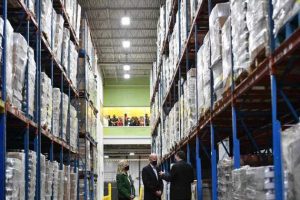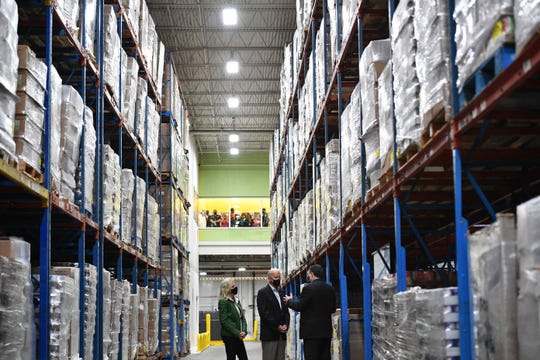A color-coded system could help people make healthier choices at food pantries, study shows

Food pantry patrons make healthier choices when foods are organized by nutrition level, new research shows.
Using a food categorizing system called Supporting Wellness at Pantries (SWAP) that ranks different foods based on its level of saturated fat, sodium and added sugars, researchers found patrons selected 11% more health foods and decreased unhealthy choices by 7%.
“The most important finding from this study is that people who go to food pantries, like all of us, want to eat a healthy diet, and it’s very hard to quickly figure out which items are the healthiest,” said Marlene Schwartz, director of the Rudd Center for Food Policy and Obesity and an author of the study. “The purpose of SWAP is to just simplify that whole process by doing all of the evaluating ahead of time, having a simple color coded system that’s very easy to understand.”
Under the system, healthiest foods, labeled green, are placed at eye level with the sign “choose often.” Less healthy foods are labeled yellow, and the least healthy foods, tagged red, go on the bottom shelf with a sign labeled “choose rarely.”
US President Joe Biden and First Lady Jill Biden with Houston Food Bank CEO Brian Greene, visit the Houston Food Bank in Houston, Texas on February 26, 2021. (Photo: Mandel Ngan, AFP via Getty Images)
Katie Martin, executive director of the Institute for Hunger Research & Solutions and the designer of the SWAP system, said the study, which evaluated choices at a food bank in the northeastern United States for a week, validates previous findings.
“There’s demand for healthy foods that vulnerable populations who are struggling, not only with food insecurity but often with chronic diseases, are interested in selecting at food pantry settings,” said Martin,a study co-author.
SWAP already is being used at 25 food banks and 50 food pantries nationwide and more are interested, Martin said.
Jessica Hager, director of Healthcare Partnerships and Nutrition at Feeding America, hopes the program catches on.
“SWAP is one of many tools that I believe food banks should consider as part of their work when it comes to engaging with communities and supporting communities’ food needs,” she said.
The need is great. Food insecurity increased during the COVID-19 pandemic, reaching an estimated 45 million people during 2020, according to Feeding America. Last year the organization saw a 44% increase in meals distributed compared to 2019, and as many as four in 10 people became first time food band users.
There’s an attitude towards the charitable food system that people should take what’s available, said Schwartz, but that’s the wrong way to think about it.
“People who are using this system, we know from research, are at higher risk of diet related to chronic diseases like Type 2 diabetes, hypertension, heart disease,” she said. “So, we almost need to go in the other direction and say what are the absolute healthiest foods that we can provide, because chances are that isn’t the type of foods that this particular family has access to otherwise afford.”
Communities of color are particularly hard hit by coronavirus, forcing local food banks to feed more with less as need increases all over the country.
USA TODAY
Source: Read Full Article

